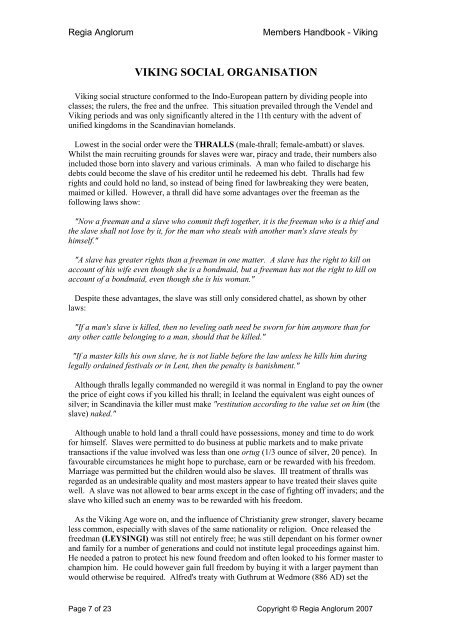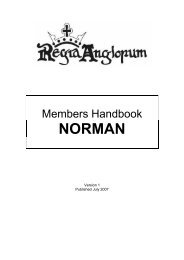You also want an ePaper? Increase the reach of your titles
YUMPU automatically turns print PDFs into web optimized ePapers that Google loves.
<strong>Regia</strong> <strong>Anglorum</strong> Members Handbook - Viking<br />
VIKING SOCIAL ORGANISATION<br />
Viking social structure conformed to the Indo-European pattern by dividing people into<br />
classes; the rulers, the free and the unfree. This situation prevailed through the Vendel and<br />
Viking periods and was only significantly altered in the 11th century with the advent of<br />
unified kingdoms in the Scandinavian homelands.<br />
Lowest in the social order were the THRALLS (male-thrall; female-ambatt) or slaves.<br />
Whilst the main recruiting grounds for slaves were war, piracy and trade, their numbers also<br />
included those born into slavery and various criminals. A man who failed to discharge his<br />
debts could become the slave of his creditor until he redeemed his debt. Thralls had few<br />
rights and could hold no land, so instead of being fined for lawbreaking they were beaten,<br />
maimed or killed. However, a thrall did have some advantages over the freeman as the<br />
following laws show:<br />
"Now a freeman and a slave who commit theft together, it is the freeman who is a thief and<br />
the slave shall not lose by it, for the man who steals with another man's slave steals by<br />
himself."<br />
"A slave has greater rights than a freeman in one matter. A slave has the right to kill on<br />
account of his wife even though she is a bondmaid, but a freeman has not the right to kill on<br />
account of a bondmaid, even though she is his woman."<br />
Despite these advantages, the slave was still only considered chattel, as shown by other<br />
laws:<br />
"If a man's slave is killed, then no leveling oath need be sworn for him anymore than for<br />
any other cattle belonging to a man, should that be killed."<br />
"If a master kills his own slave, he is not liable before the law unless he kills him during<br />
legally ordained festivals or in Lent, then the penalty is banishment."<br />
Although thralls legally commanded no weregild it was normal in England to pay the owner<br />
the price of eight cows if you killed his thrall; in Iceland the equivalent was eight ounces of<br />
silver; in Scandinavia the killer must make "restitution according to the value set on him (the<br />
slave) naked."<br />
Although unable to hold land a thrall could have possessions, money and time to do work<br />
for himself. Slaves were permitted to do business at public markets and to make private<br />
transactions if the value involved was less than one ortug (1/3 ounce of silver, 20 pence). In<br />
favourable circumstances he might hope to purchase, earn or be rewarded with his freedom.<br />
Marriage was permitted but the children would also be slaves. Ill treatment of thralls was<br />
regarded as an undesirable quality and most masters appear to have treated their slaves quite<br />
well. A slave was not allowed to bear arms except in the case of fighting off invaders; and the<br />
slave who killed such an enemy was to be rewarded with his freedom.<br />
As the Viking Age wore on, and the influence of Christianity grew stronger, slavery became<br />
less common, especially with slaves of the same nationality or religion. Once released the<br />
freedman (LEYSINGI) was still not entirely free; he was still dependant on his former owner<br />
and family for a number of generations and could not institute legal proceedings against him.<br />
He needed a patron to protect his new found freedom and often looked to his former master to<br />
champion him. He could however gain full freedom by buying it with a larger payment than<br />
would otherwise be required. Alfred's treaty with Guthrum at Wedmore (886 AD) set the<br />
Page 7 of 23 Copyright © <strong>Regia</strong> <strong>Anglorum</strong> 2007



